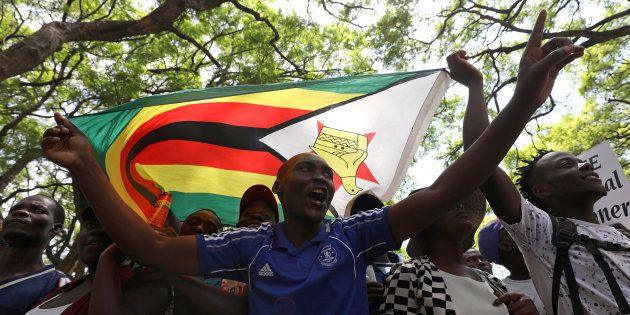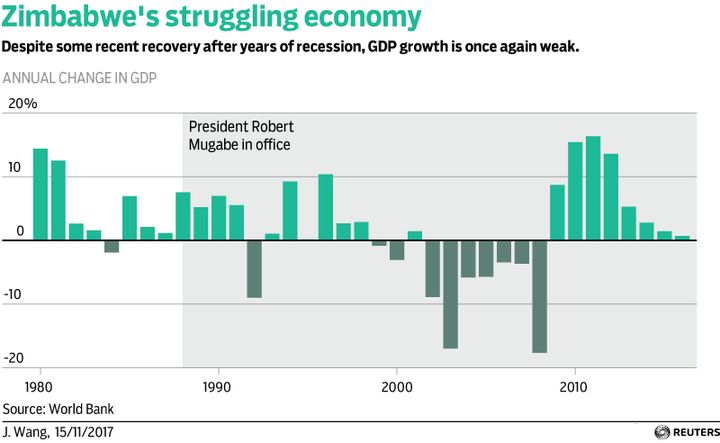
After an iron grip on Zimbabwe for 37 years, Robert Mugabe has finally buckled under pressure and resigned as president of that country on Tuesday afternoon amid impeachment proceedings against him in Parliament.
In those 37 years, Mugabe has obliterated his country's economy. Let's go back in time and examine Mugabe's fraught legacy.
The year is 1980 and Rhodesia is no more, having just gained independence, marking its newfound liberation with a new name and a new president. Robert Mugabe takes the political throne in Zimbabwe. There is jubilation in the streets as the new government announces its new health- and education-focused programmes and policies.
Zimbabwe's growth rate for the decade is higher than sub-Saharan Africa as a whole. Mother nature also pays her respects -- good annual rainfall boosts farming outputs and Zimbabwe's growth is on a steady upward trajectory.
Fast-forward 20 years from the end of the decade.
More than 3-million Zimbabweans live in extreme poverty. The country experiences a precipitous collapse in its economy -- inflation is in triple digits; the local currency loses 99% of its value and more than a quarter of its citizens have fled the country.
However, Mugabe remains at the helm.
The effects of his regime -- marked by hyperinflation, frenzied land distribution and penniless state-owned enterprises -- will not ephemerally disappear.
Failed Economic Policies
Mugabe's woes began in his early years as president when the country was struck by drought and a world recession resulted in commodity export prices decreasing. To combat this, Mugabe decided to shift economic policies, implementing the Economic Structural Adjustment Program (ESAP) that allowed for an open market economy.
But the plan failed. At the time, performance indicators showed the economy grew by at an average of 4.3 percent per annum in the '80s but deteriorated to 0.8 percent when new policies were implemented, mainly because Zimbabwe's manufacturing industry was exposed to foreign competition.
Realizing that the project had failed, Mugabe's government instituted another set of policies called the Zimbabwe Program for Economic and Social Transformation aimed at improving the ESAP. But due to poor fiscal policies, the budget deficit continued to grow and foreign currency reserves were left staggered.

Unbudgeted civil unrest and war
As Zimbabwe's economic decay became more visible in the late '90s, and civil unrest broke out throughout the country, the government was somewhat forced to pay war veterans a once-off gratuity and a sizeable monthly pension -- funds for which they had to borrow.
Then Zimbabwe entered the war in the Democratic Republic of Congo in 1998, which was said to have cost the country almost 6-billion Zimbabwean dollars.
Land reform
Still a highly contested topic for its impact on Zimbabwe's economy and agricultural output, Mugabe at the turn of the century established the Fast Track Land Reform Programme to redistribute land to the black majority in the country.
Occupation of land continued unrestrictedly until 2003 and, two years afterwards, government passed an amendment declaring all agricultural land as belonging to the state.
In the period of land reform, Zimbabwe's economy declined exponentially. Real GDP plummeted 45 percent in the decade leading up to 2009 and by 2008, output volumes were two-thirds below peak. According to statistics from the country's Commercial Farmers' Union, wheat production declined from around 270,000 tons in 1998 to 62,000 tons in 2007.
Hundreds of thousands of farm labourers were also displaced and food production dived with half the population left reliant on food aid by 2003.

Hyperinflation
By 2006, Zimbabwe's annual inflation rose above 1,000 percent and, as time progressed, the introduction of new bills flooded the market. The world saw Zimbabwe's economic decline through its citizens hauling wheelbarrows of cash money to stores for a loaf of bread.
This later grew to the point where a 100-trillion-dollar bank note was released into circulation.
Mugabe and his government failed again to fix the problem. In an effort to save consumers from the deteriorating Zimbabwean dollar, government implemented price controls on basic goods.
But naturally, citizens rushed to shops to purchase the vastly cheaper products, eroding profits made by manufacturers and leading to many companies having to close their doors.
In an economic period of hyperinflation, Zimbabwe was forced to abandon its currency and replace it with the US dollar in 2009 and further had to resolve to issuing bond notes last year in efforts to introduce some form of liquidity.
The anticlimactic climax
On Tuesday, AFP reported that Zimbabwe's parliament had started the parliamentary process of impeaching Mugabe, which could lead to him being stripped of office.
This comes after the military earlier this month seized power and tens of thousands of citizens took to the streets to demand the 93-year-old's resignation.
However, for Zimbabwe, this may be two decades too late.
A political regime change may save Zimbabwe from Mugabe now, but his legacy and its effects on the country will continue as the country embarks on a long, long road to recovery.
